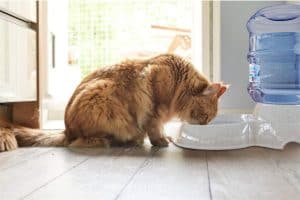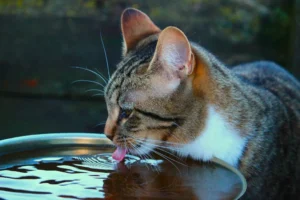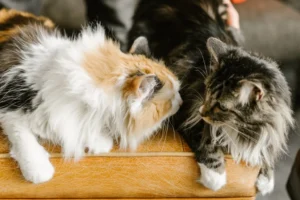Cats are fascinating creatures with many unique behaviors that leave us curious. One such behavior is how cats drink with their tongue, a seemingly simple action that actually involves a complex, specialized process. Have you ever wondered why cats drink this way? Let’s explore the fascinating science behind cats’ drinking habits.
The Science of Cats’ Tongues
Have you ever wondered why cats seem to drink water in such a peculiar way? Well, it all comes down to the fascinating anatomy of a cat’s tongue. Unlike humans and many other animals, a cat’s tongue is covered in tiny backward-facing spines called papillae. These papillae are what give the tongue its rough texture and serve a unique purpose when it comes to drinking.
When a cat dips its tongue into a bowl of water, those papillae actually help to pull the liquid up into a column. As the cat retracts its tongue, gravity takes over and the water is essentially scooped into their mouth. This clever mechanism allows cats to drink more efficiently, especially in arid environments where water can be scarce.
Additionally, the spines on a cat’s tongue are also thought to play a role in grooming. When a cat licks its fur, these tiny structures help to remove dirt and loose hair, keeping the cat clean and sleek. So next time you see your feline friend taking a drink, remember that their unique tongue is what sets them apart in the animal kingdom.
Why Do Cats Lap Water Instead of Sip?
You might be wondering why cats choose to lap water with their tongues rather than simply sipping it like we do. The answer lies in evolution. Cats are natural predators, and their ancestors in the wild would often rely on bodies of water for hydration. By lapping water, cats are able to minimize the amount of liquid they come in contact with, reducing the risk of getting their sensitive whiskers wet.
Moreover, the quick and efficient motion of lapping allows cats to drink without losing focus on their surroundings. In the wild, being alert and aware of potential threats is crucial for survival. So, by using their tongues to lap up water, cats can stay vigilant and ready to react at a moment’s notice.
Next time you see your cat indulging in a drink, appreciate the unique behavior that stems from their instincts as skilled hunters. Cats have certainly mastered the art of hydration in their own special way.
The Physics of a Cat’s Drinking Style
Have you ever watched a cat drink water and marveled at how effortlessly they do it? It turns out that there’s some fascinating physics behind a cat’s unique drinking style. When a cat approaches a water source, they delicately lap up the water using the tip of their tongue. Unlike dogs that scoop water into their mouths, cats use a specialized technique to create a water column.
Here’s how it works : As a cat extends its tongue to touch the water’s surface, it quickly retracts its tongue, causing a column of water to follow inertia into their mouth. This quick and precise action allows cats to drink without creating a messy splash. In fact, cats only touch the tip of their tongue to the water for a split second, relying on gravity and inertia to bring water into their mouth.
Next time you see your feline friend drinking, take a moment to appreciate the intricate physics behind their elegant technique.
Hydration Techniques of Felis Catus
Keeping your cat hydrated is crucial for their overall health and well-being. Unlike humans who can rely on sweat to regulate body temperature, cats primarily use panting and grooming to cool down, making hydration even more essential for them. The unique drinking style of cats, with their specialized tongues, plays a vital role in helping them stay hydrated.
Here’s why : Cats have tiny, hook-like structures on their tongues called papillae that point backward. These papillae help create a rough texture on the cat’s tongue, which assists in drawing water upward. Additionally, a cat’s tongue can move incredibly fast, making it efficient at lapping up water in small, precise amounts.
Incorporating wet food into your cat’s diet can also aid in their hydration since approximately 70-80% of a cat’s water intake comes from food. Providing multiple water sources around your home and keeping them fresh can encourage your cat to drink more.
Remember, proper hydration is key to keeping your cat healthy and happy.
Evolutionary Adaptations in Cat Drinking Behavior
Cats drink water in a unique way by using their tongue to lap it up. This behavior has evolved over time to be incredibly efficient. Unlike dogs who use their tongues to form a cup-like shape, cats have tiny spines called papillae on the surface of their tongue that help create a backward-facing hook-like shape. When a cat dips its tongue into water, these papillae rapidly extend, flick the liquid up, and the cat closes its mouth quickly to capture the water. This process allows cats to drink quickly and quietly, mimicking the efficient hunting behavior of their wild ancestors.
Curious Cat Behavior: Splashing Water While Drinking
Some cats exhibit the quirky behavior of splashing water while they drink. This splashing action can serve a few purposes. One reason may be that the cat is testing the water’s depth or cleanliness before drinking. Another possibility is that cats enjoy the sensory experience of playing with water and find the splashing fun and stimulating. Additionally, some cats may splash water to avoid drinking stagnant water or to ensure that their environment is safe for drinking. While this behavior might seem messy, it’s a normal part of a cat’s natural instincts and curiosity.
Reasons Cats Splash Water While Drinking:
- Testing Water Depth: Cats might splash water to gauge how deep the liquid is before actually drinking it.
- Sensory Stimulation: Splashing water can provide cats with a playful sensory experience they enjoy.
- Safety Concerns: Some cats splash water to ensure it’s safe or to avoid drinking stagnant water.
- Natural Instincts: This behavior can also stem from a cat’s curiosity and innate playful nature.
- Environmental Adaptation: Splashing water might be a way for cats to adapt to their surroundings for better safety and wellness.
Remember, each cat is unique, so while some may enjoy splashing water, others may prefer a more straightforward drinking method.
How Can You Help Your Cat Stay Hydrated?
Cats drink water by using their unique tongue to lap it up. This method helps them stay hydrated and healthy. To ensure your feline friend is getting enough fluids, here are some tips:
Fresh Water : Always provide your cat with fresh, clean water in a shallow dish. Cats are picky about their water source, so ensure it is changed regularly.
Multiple Water Stations : Place water bowls in various locations around the house to encourage your cat to drink more often. Some cats prefer running water, so consider investing in a cat fountain.
Wet Food : Incorporate wet food into your cat’s diet as it contains higher moisture content compared to dry food. This can help with their overall hydration.
Flavored Water : Cats may be enticed to drink more if you add a flavor they enjoy, such as a small amount of tuna juice or low-sodium chicken broth to their water.
Regular Vet Check-ups : Ensure your cat has regular check-ups with the vet to monitor their hydration levels and overall health.
By following these tips, you can help keep your cat hydrated and happy.
Fun Facts About Cats’ Drinking Habits
Cats have a fascinating way of drinking water that sets them apart from other animals. When cats take a drink, they use a process known as “lapping.” Their tongues have tiny spines called papillae that help create a backward-facing hook to pull liquid into their mouths. Here are some entertaining facts about cats’ drinking habits:
- Speedy Drinkers: Cats are incredibly efficient drinkers. They can lap up to four times per second, making their drinking process quick and effective.
- Minimal Splashing: Unlike dogs, cats are meticulous drinkers and create very little splashing when they drink water. This is due to the unique way they curl their tongues to prevent spillage.
- Optimal Lapping Strategy: Cats use gravity to their advantage when lapping up water. They carefully balance the forces of inertia and gravity to efficiently transfer water from the bowl to their mouths.
Next time you see your cat taking a sip, take a moment to appreciate the intricate and fascinating process they use to stay hydrated.
The Mystique of Cats’ Tongue Drinking
Have you ever noticed how gracefully cats drink water with their tongues? It’s not just an ordinary act; it’s a marvel of nature! When a cat curls its tongue backward, it actually forms a super efficient ladle to scoop up water. While we may take sipping for granted, cats have evolved a unique technique to stay hydrated.
Cats’ tongues are covered in tiny, hook-shaped structures called papillae. These papillae make their tongues feel rough to the touch but serve a crucial purpose when it comes to drinking. As a cat dips its tongue into a bowl of water, the papillae will actually bend backwards. This creates a liquid column that the cat swiftly closes its jaws around, almost like a liquid rope. It’s a precise process that shows off the intricate design of nature at its finest.
Next time you watch your feline friend take a sip of water, appreciate the beauty and complexity of their tongue’s design. It’s a reminder of how amazing the animal kingdom truly is, with each creature having its own unique way to navigate the world. Now you know why cats drink with their tongue—it’s not just a simple act, but a fascinating display of nature’s ingenuity.
A Closer Look at Cat’s Drinking Technique
- Efficient Design: Cats’ tongues are not just for grooming; they are finely tuned tools for drinking. The backward-curving papillae on their tongues create a hydraulic pressure that enables them to lap up water efficiently.
- Quenching Thirst: When a cat laps up water, it’s not just about satisfying thirst. This unique drinking technique allows cats to drink water without getting their whiskers wet, a handy feature for these fastidious creatures.
- Adaptations in the Wild: Wildcats in the wild rely on their tongue-drinking technique to stay hydrated when water sources are scarce. Their specialized tongues have evolved to be the perfect drinking tool in various environments.
So, the next time you see your cat delicately sipping water, remember that their sophisticated drinking technique is a beautiful blend of biology and adaptation.
For more in-depth information on cats’ grooming habits and behavior, check out this resource.
Alex, a passionate animal lover, has experience in training and understanding animal behavior. As a proud pet parent to two dogs and three cats, he founded AnimalReport.net to share insights from animal experts and expand his knowledge of the animal kingdom.









